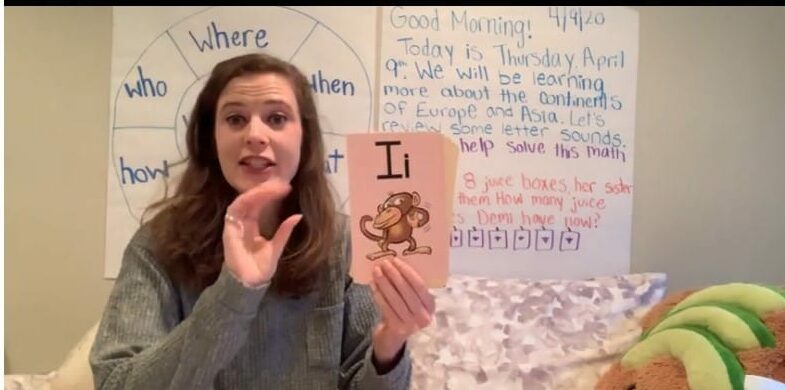I didn’t know my “last day” of in-person teaching with my students was going to be my last day. Like most teachers, I didn’t have a chance to say any kind of a special goodbye let alone send home books, activities, or detailed plans for how we’d continue to learn together. But in the past couple of weeks, my colleagues and I have learned a lot about how we can connect with and teach 75 five-year-olds remotely. We certainly don’t have this all figured out, but I’d like to share some of the things that have worked for us!
Connect with Your Students and Their Families
Our district encourages us to call home to our students’ families at least once a week. This has helped us gain a better picture of the challenges that might face our students when it comes to online learning—and helped us, as educators, design learning that acknowledges these challenges. For instance, while most of our students have some form of internet at home, some only have access to a cell phone—and many apps work very differently on a cell phone than they do on a tablet or laptop. From these calls I also learned why live, synchronous learning during traditional school hours wouldn’t work for my students. One student’s mother was now working a night shift, so she and her children were now sleeping during the days. Another family had only one internet-enabled device and it was being used by the 7th grade student for his live online learning; my student could use it only once his sibling was done.
Flexibility with communication is essential during this time. I’m grateful that I started using the free app ClassDojo long before the pandemic hit, but not all my families use it consistently or with the same comfort level. So while it’s a great tool for communication or even submitting online assignments, it also been crucial for me to make calls, send texts, or have parents friend me on Facebook.
Divide, Conquer, and Collaborate
In my school, we have three kindergarten classes. My colleagues and I have decided to split the work of online instruction and planning between us. I lead language arts, while my other colleagues focus on reading foundational skills and math, respectively. My colleagues in other grades have opted to rotate days of instruction, with each teacher leading all subjects on their assigned days. Our district has provided online videos to accompany our curriculum, but we know uptake of these videos is spotty, and connection to us and their peers is so important to students right now. We want to offer them as much of their kindergarten experience as we can, fully acknowledging that situations are fluid. For some students, school isn’t a priority this week with a parent working new hours or a family member sick. But it may be next week. Or the week after. We want to be ready to serve all our students when they’re able to engage with us.
Use Technology to Support What Matters Most
Since I know that most of my students can’t sign on consistently to remote online classes, we use any live online meetings for catching up and getting to see one another! I’m really proud of how my students are applying our classroom norms of waiting until their friends have finished speaking before sharing, and being respectful to one another via this new communication channel. (Although I admit to using the mute button a few times!)
The majority of the instruction we’re delivering is done through pre-recorded YouTube videos. Students can access them whenever they’re able to and can re-watch them as often as they’d like. I record a daily Morning Message for my students each day, just like we did in-person.

I review our class rules (patience, no whining, kindness, etc.) which are just as important to practice at home as in the classroom! We also go over some of the key literacy and numeracy concepts they’ve been working on through other videos.

At first, students accessed this directly through our class YouTube channel, but my colleague recently created our kindergarteners their very own website, where we can upload not only our own video lessons, but also other videos from YouTube, NatGeo Kids, and other sources of free media that complement our instruction. And we have a beautiful venue to celebrate the students’ own work, just like we would in the classroom and hallways at school.


Since we weren’t able to send books home with students, our reading instruction has focused around knowledge-building read-alouds. I’ll read a book aloud for students via YouTube video, and then students submit a “notice” and a “wonder”—a routine familiar to them from before we left school—via whatever means they can get it to me: Class Dojo, putting their answer in the comments of the YouTube video, drawing a picture and having a parent text it to me, etc. I try to share a lot of their responses and I’ve heard from parents that hearing their names and responses said aloud on YouTube is pretty exciting for students!

We’re attempting to continue our learning trajectory via our curriculum, Wit and Wisdom, but obviously many of the components just aren’t feasible right now. We’re trying to focus on knowledge building, and even though students don’t have access to the curriculum’s texts, I’ve made use of Epic (free for teachers and students right now) to create collections of free topic-focused texts about the seven continents (our current unit).
A Few Final Thoughts
Be flexible. Be patient. Be optimistic. Easier said than done, but I’ve been trying to be kinder to myself and to others recently. My days don’t look like they used to—I don’t work typical school hours. I lead online meet-ups on weekends when more students can attend, and I sometimes chat with parents late at night once they get off work. But that means I can do things I couldn’t before—like take a walk in the middle of the day. And that’s important!
I encourage my fellow teachers to remain optimistic about the effect they’re having on their students during this time. It can be discouraging to look at the number of views of a recorded lesson—comparing the number of students who’d normally be in class desks with the number that watched. But remember, if it matters for even just one student, you’re making a difference. And students’ situations change. So while a student might not be able to watch today or tomorrow, they may be watching on the weekend, next week, or even next month. The learning is waiting for them along with your familiar, comforting, and encouraging presence.
Keep up the good work!
















